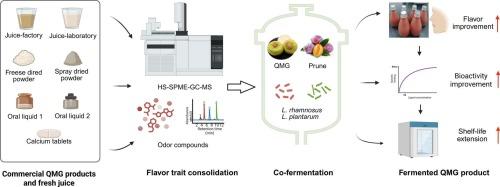Co-fermentation with lactic acid bacteria and prune puree modulates volatile profile and bioactivity of Qiamagu juice
IF 8
1区 农林科学
Q1 FOOD SCIENCE & TECHNOLOGY
引用次数: 0
Abstract
Brassica rapa L., a specialty crop from Xinjiang known as Qiamagu (QMG), has limited processing and market application due to its pungent off-flavor and perishability. This study aimed to characterize the volatile compounds responsible for the undesirable flavor in QMG processed by different methods, and to evaluate the effects of combined lactic acid bacteria (LAB) fermentation with prune puree addition on fresh QMG juice's flavor and bioactivity.
Volatile compounds of five kinds of QMG products and fresh juice were analyzed using headspace solid-phase microextraction coupled with gas chromatography–mass spectrometry (HS-SPME-GC–MS), identifying isothiocyanates and nitriles as the primary contributors to pungency. Fresh QMG juice was fermented with Lacticaseibacillus plantarum and Lacticaseibacillus rhamnosus, combined with Xinjiang prune puree. Sensory evaluation, bioactivity assays, and storage tests were conducted to assess quality changes. Shelf life was predicted using kinetic modeling based on uric acid inhibition data.
Fermentation and prune puree addition significantly reduced sulfur-containing compounds from 14,411.40 μg/L to 1089.30 μg/L, while aldehydes, esters, and alcohols increased, enhancing floral and fruity aromas. Sensory scores of fermented samples reached 74, surpassing fresh juice at 39.71. Bioactivity improved with a 39.00 % increase in uric acid inhibition rate, a 6.39 % rise in superoxide dismutase activity, and polysaccharide content elevated from 99.96 to 109.85 mg/mL. Storage at 4 °C slowed degradation of active components, with a predicted shelf life of approximately 330 days.
These results demonstrate that LAB fermentation combined with prune puree addition effectively improves QMG flavor and functional properties, providing a scientific basis for its development as a functional food ingredient. By simultaneously reducing undesirable flavors and enhancing bioactivity, this strategy promotes QMG from an underutilized crop to a promising functional food ingredient with significant market potential. Furthermore, it provides a generalizable approach for optimizing flavor and functional quality in other Brassica L based foods.

乳酸菌与西梅泥共发酵对恰马古果汁挥发谱和生物活性的影响
新疆特产恰马古油菜(QMG)因其气味刺鼻、易腐烂,制约了其加工和市场应用。本研究旨在对不同加工方法加工青豆浆中产生不良风味的挥发性物质进行表征,并评价乳酸菌联合发酵添加西梅泥对青豆浆鲜汁风味和生物活性的影响。采用顶空固相微萃取-气相色谱-质谱联用技术(HS-SPME-GC-MS)对5种QMG产品和鲜榨果汁的挥发性成分进行了分析,鉴定出异硫氰酸酯和腈是主要的刺激性成分。以植物乳杆菌和鼠李糖乳杆菌为原料,结合新疆梅干泥发酵青mg鲜汁。通过感官评价、生物活性测定和储存试验来评估质量变化。使用基于尿酸抑制数据的动力学模型预测保质期。发酵和添加西梅果浆显著降低了含硫化合物的含量,从14411.40 μg/L降至1089.30 μg/L,而醛、酯和醇的含量增加,增强了花香和果香。发酵样品的感官得分达到74分,超过鲜榨果汁的39.71分。生物活性提高,尿酸抑制率提高39.00%,超氧化物歧化酶活性提高6.39%,多糖含量从99.96 mg/mL提高到109.85 mg/mL。在4°C下储存可减缓活性成分的降解,预计保质期约为330天。综上所述,酵母发酵联合添加西梅泥可有效改善青豆豉的风味和功能特性,为开发青豆豉作为功能性食品配料提供了科学依据。通过同时减少不良风味和提高生物活性,该策略将QMG从一种未被充分利用的作物发展成为具有巨大市场潜力的功能性食品原料。为其他芸苔类食品风味和功能品质的优化提供了可推广的方法。
本文章由计算机程序翻译,如有差异,请以英文原文为准。
求助全文
约1分钟内获得全文
求助全文
来源期刊

Food Research International
工程技术-食品科技
CiteScore
12.50
自引率
7.40%
发文量
1183
审稿时长
79 days
期刊介绍:
Food Research International serves as a rapid dissemination platform for significant and impactful research in food science, technology, engineering, and nutrition. The journal focuses on publishing novel, high-quality, and high-impact review papers, original research papers, and letters to the editors across various disciplines in the science and technology of food. Additionally, it follows a policy of publishing special issues on topical and emergent subjects in food research or related areas. Selected, peer-reviewed papers from scientific meetings, workshops, and conferences on the science, technology, and engineering of foods are also featured in special issues.
 求助内容:
求助内容: 应助结果提醒方式:
应助结果提醒方式:


